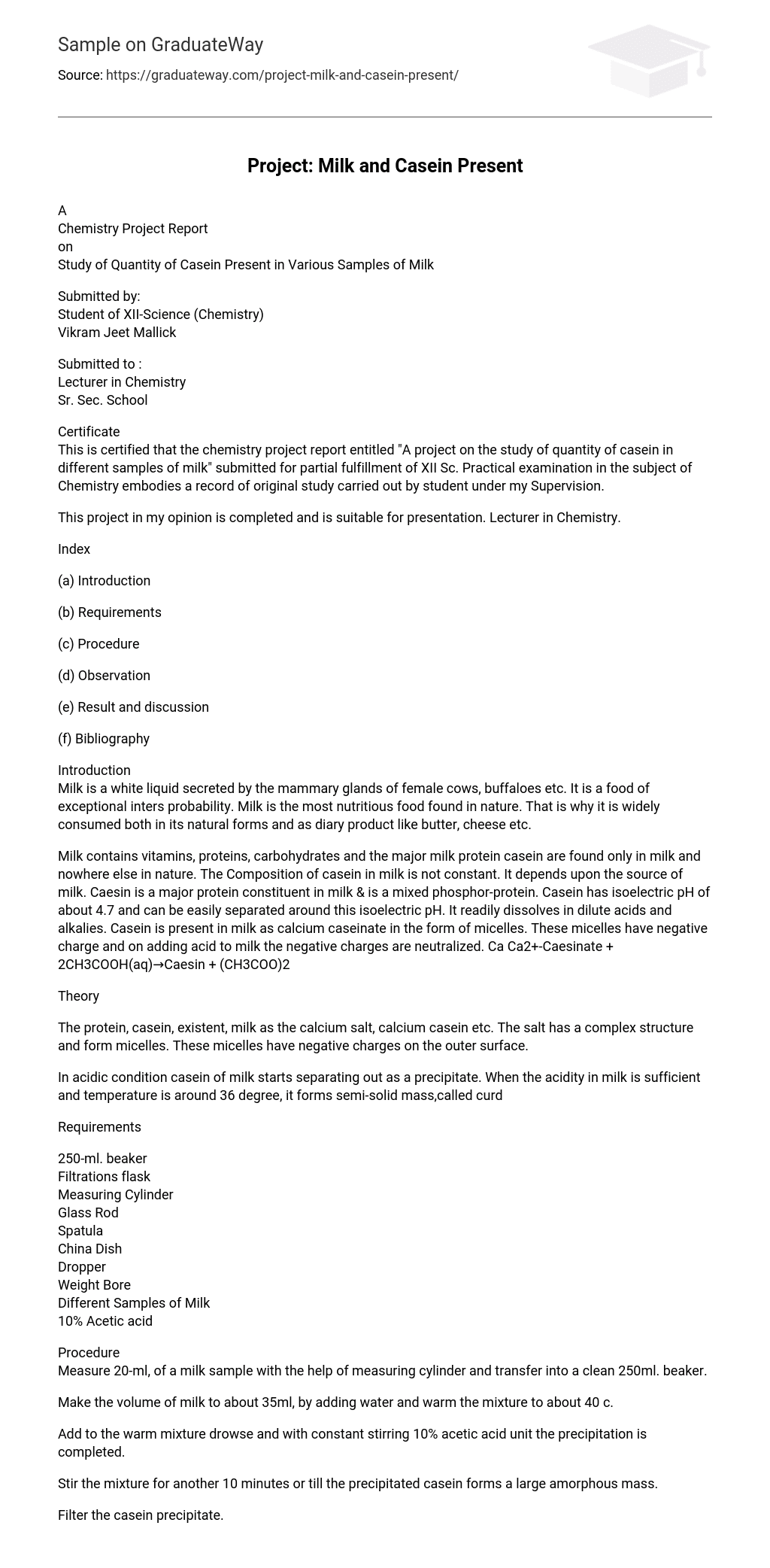A Chemistry Project Report examining the amount of Casein in different Milk Samples.
Submitted by:
Student of XII-Science (Chemistry)
Vikram Jeet Mallick
Submitted to:
Lecturer in Chemistry
Sr. Sec. School
Certificate
This is to confirm that the project report on studying the quantity of casein in various milk samples, titled “A project on the study of quantity of casein in different samples of milk,” has been submitted as a partial fulfillment for XII Sc. Practical examination in Chemistry. The report represents an authentic research carried out by the student under my guidance.
From my point of view, a Chemistry lecturer has evaluated this project and now deems it complete and suitable for presentation.
Index
Introduction
(b) Requirements
(c) Procedure
(d) Observation
(e) Result and discussion
(f) Bibliography
Introduction
Milk is a valuable food produced by the mammary glands of female cows, buffaloes, and other animals. It is a white liquid that is highly nutritious and considered one of nature’s most nourishing substances. Milk is widely consumed in its original form and in various dairy products like butter and cheese.
Milk contains a variety of nutrients including vitamins, proteins, and carbohydrates. The primary protein in milk is casein, which is only found in milk and not naturally occurring in other sources. The composition of casein varies depending on the origin of the milk. Casein consists of phosphor-protein and makes up a significant portion of the protein content in milk. It has an isoelectric pH value around 4.7, making it easily separable at this specific pH level. When exposed to weak acids or alkalies, casein can be dissolved. In milk, casein exists as calcium caseinate within micelles – small particles with a negative charge. This negative charge can be neutralized by adding acid to the milk, resulting in the formation of caesin and (CH3COO)2 through interaction between Ca2+-Caesinate and 2CH3COOH(aq).
Theory
The protein found in milk, known as casein, occurs as the calcium salt called calcium casein. This salt possesses a complex structure and forms micelles, which have negative charges on their outer surface.
In an acidic environment, milk undergoes a separation process where the casein in it solidifies and becomes a precipitate. This results in the formation of curd, which is a semi-solid mass, typically occurring at around 36 degrees.
Requirements
250-ml. beaker, Filtrations flask, Measuring Cylinder, Glass Rod, Spatula, China Dish, Dropper, Weight Bore, Different Samples of Milk, 10% Acetic acid
Procedure: Measure 20 ml of a milk sample using a measuring cylinder and transfer it into a clean 250 ml beaker.
Adjust the volume of milk to approximately 35ml by diluting it with water and then heat the mixture to around 40°C.
Continuously stir and add 10% acetic acid to the warm mixture until precipitation is finished.
Continuously stir the mixture for an additional 10 minutes or until the casein precipitates and forms a significant, shapeless mass.
Remove the casein precipitate through filtration.
Thoroughly wash with water, then dry the foils between folds of filter paper and in air for 1-2 days. Finally, weigh the dry solid obtained.
Similarly, establish the quantity of casein in other milk samples.
Observation
Volume of Milk Taken in each case = 20ml.
Sample No.
Quality of Milk
Weight of casein
percentage of casein
1.
SARAS
0.60
3.00%
2.
PANCHAMRAT
0.65
3.25%
3.
AMUL
0.85
4.20%
4.
RATH
0.75
3.70%
Therefore if an acid is added to milk the negative charge are neutralized and the neutral protein precipitated out.
Ca+2 (casemated) +2 CH3 COOH (aq)
Casein + (CH3 COO)2 Ca
Results and Discussion
The casein content varies in different samples of milk, but the amul brand has a significant amount of casein. Currently, amul is the top choice for milk in the market.
Bibliography
Laboratory manual in chemistry Class XII by B.Bhushan
Advanced organic practical chemistry for P.G. Students & by O.P. Agarwal. Internet Source: www.google.com www.yahoo.com





